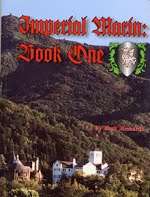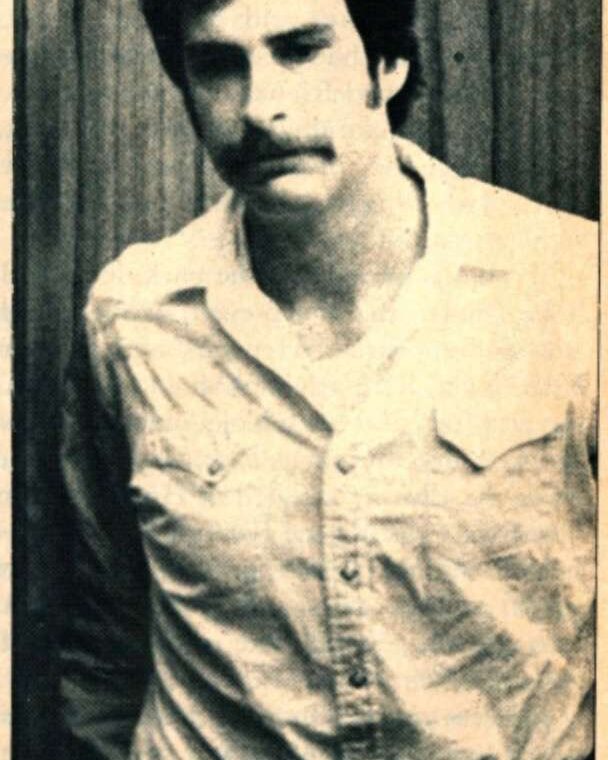
Pendragon
Mark had long been working on a book about Pendragon, an Arthurian kingdom set in Marin County. After starting the construction business, he took his took his partner into the Marin Headlands and told him that it would be nice if the area was under his control. Those who knew Mark describe how Pendragon became increasingly real to him. (California Magazine, “Pendragon Chronicles.”)

Mark met with a group of teens, including Crossan, to discuss how Pendragon could be established. Richards would be the king, his group would be knights and hold titles such as counts, earls, or dukes. The theological seminary (pictured) was to be the headquarters; prisoners would be released from San Quentin to help secure the kingdom; laser weapons that had yet to be invented would defend the area from Angel Island and Mount Tamalpais.
Richards told the teens that George Lucas was helping to fund the plan. Willie Robles, a former worker for Richards, described Pendragon as a vigilante group and testified that Mark had paid him to try to recruit new members. Mark took a friend to Mount Tamalpais to demonstrate his plan for an insurrection. He threatened to “eliminate” another former worker if he revealed anything about Pendragon.
Although guns, maps, plans for a laser weapon, and other material relating to Pendragon had been found in Mark’s home after the crime, his attorneys dismissed talk of an uprising and the importance of Pendragon: “Mark’s role-model was King Arthur. Pendragon was the dream of a young man who wanted to be King Arthur. Is that evidence of a crime? He has a creative imagination.”
The defense contended that the Pendragon material was simply part of his fantasy book. Mark’s former wife testified that he was working on a book – Imperial Marin. Mark contended that he never intended to take over the county but used the teens as sounding boards for his novel.[6]

The Crime
Richards told Hoover that Baldwin was a pedophile, and rapist: “it would be a service to the public to get rid of such a menace.” These accusations enraged Crossan against Baldwin. (Hoover v. Carey.) Mark acknowledged to investigators that he knew Hoover was sensitive against “perverts and homosexuals” and used that to “jerk up” Crossan against Baldwin. Mark stated that he did not know for certain whether Baldwin was gay or bisexual. (See Detective Interrogation of Richards.)
Regardless of whether the murder was linked to Pendragon or more mundane motives, the plans proceeded. Andrew testified that they weren’t going to turn Mark in just because he was talking about killing somebody.
Richards and the teens met with Baldwin, who offered them oatmeal-raisin cookies. Richards and Hoover went with Baldwin to his garage to look at his classic cars. Andrew testified that he stayed in the house. Upon a prearranged signal from Mark, Hoover committed murder. Mark stood next to him as the crime was committed.
The killing took place while Andrew was searching Baldwin’s house to carry out the theft. Mark told Andrew that the murder had been “bloody” and that he wanted to get things out of the house quickly. The three took a small safe, cash, guns, and marijuana from Baldwin’s house. That same day, Mark bought a boat with proceeds from the crime, which was used to dump Baldwin’s body. A security guard questioned Mark when the group arrived at the marina, but let them pass.
As the group headed out into the bay, the boat engine stalled several times and they weren’t able to go as far as planned. They intended to use a carton of weights to sink the body but the rope broke and they had to use a small outboard motor. Richards did not return home until 3:00 a.m.
Because of Mark’s financial problems, both Caryn, Mark’s wife at the time, and a former employee were surprised when Mark bought the boat, gifts of jewelry, and video equipment after the crime. (Murder in Camelot; California Magazine, “Pendragon Chronicles.”) Caryn has said Mark was very emotional after the murder and professed his love to her – asking if she would love him, no matter what. (Kevin Moore, Murder in Camelot trailer.)
Baldwin’s body was found a week after the murder when it floated to the surface. Hoover began to talk about the crime. The investigators received a tip that named Richards as being involved with the killing. The group was arrested three days later as they left Mark’s house in his pickup truck.
Cable and plastic sheeting were found in the truck that matched what was used to dispose of the body. Richards used Baldwin’s checks and credit cards to go on a spending spree. Items associated with Baldwin – including guns stolen from the victim – were found in Mark’s possession. Mark’s fingerprints were found on forged checks belonging to Baldwin and a credit application that he had filled out under Baldwin’s name. Witnesses reported seeing a drilled-out safe in Mark’s garage after the murder was committed.
After the arrest, Hoover gave a lengthy statement to the investigators recounting Mark’s involvement in the crime and admitting his own actions. In a separate four hour interview Richards told the investigators that Baldwin was his friend who had hit his head in Mark’s boat while they were together. Mark maintained that he had used Baldwin’s credit cards with his consent, as a way for Baldwin to start to pay off a debt. When the detectives accused Mark of lying, he acknowledged his financial problems and admitted to having taken items from Baldwin’s house after the crime. He said that he helped to cover up the killing, but blamed the killing on the teens.
At Trial
Mark was represented by two highly respected attorneys, among the best in the state (Carl Shapiro and Dennis Riordan). The defense attacked the prosecutor’s chronology and Andrew’s credibility, who testified against Richards under a grant of immunity. They argued that although Richards participated in an attempted coverup of Baldwin’s murder, he had done so only out of misguided loyalty to his employees. Shapiro contended that Andrew, not Mark, should have been on trial for murder.
Mark states that the science fiction writer Phillip Dick wanted to testify as an alibi witness but that he was not allowed to do so. Numerous friends were allegedly killed to prevent them from testifying. (Cassidy, Interview IV.) Dick died before the crime was committed, two years before the trial – that Mark’s friends were killed is similarly not substantiated.
The jury deliberated four days before convicting Mark of first degree murder. Mark was stunned, believing that at most he would only be convicted of being an accessory after the fact for helping dispose of the body. After the verdict was announced, he whispered that he had not done the crime.

At least one of the jurors stated that Pendragon did not factor into their decision and that there was more than enough evidence apart from Campbell’s testimony to justify their verdict. The trial court found that there was “overwhelming” evidence to support the verdict. Mark was sentenced to life without parole.
The length of the deliberations in the Richards case arguably indicates that the verdict was a close one. Yet, there was no question that Mark was involved with the murder – the only issue at trial was whether he was the mastermind or an accessory who tried to cover up the crime. There is a substantial difference between the two in legal terms, but neither one squares with Mark’s claim of having been a high level operative. The type of character, skills, knowledge, and connections that the latter would possess is at odds with the events surrounding the Baldwin murder.


